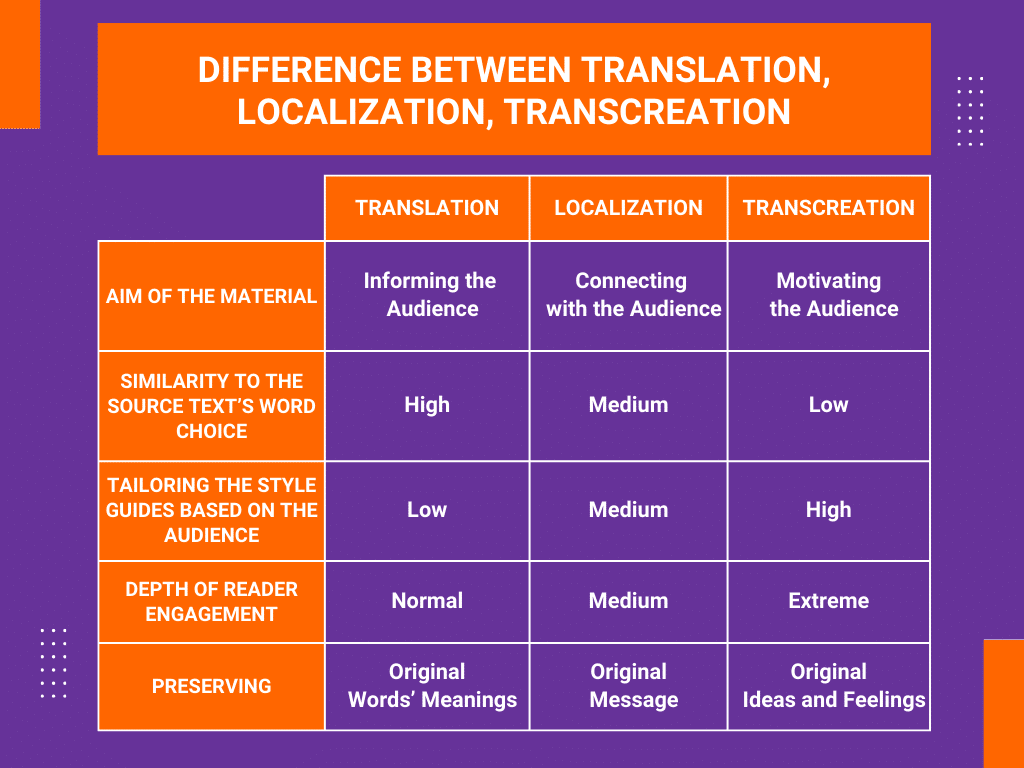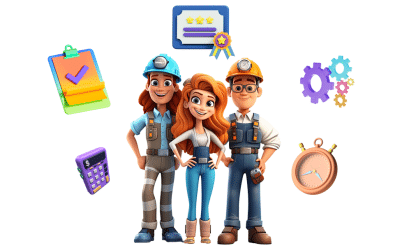Last Update on:

Translation, localization, and transcreation are critical components of global communication. Each of these processes plays a unique role in facilitating a safe and reliable exchange of ideas across the world. As such, it is essential to understand the distinctions among them before selecting the most appropriate method for your content.
This article will delve into the differences between translation, localization, and transcreation and highlight how each contributes to a successful multilingual communication strategy. To begin, we will provide clear definitions of these three essential processes. Following is a detailed examination of their key distinctions. Lastly, we will consider the various factors one should consider when deciding between translation, localization, and transcreation. By familiarizing oneself with these concepts, one can make informed decisions that will help to ensure effective communication across borders and cultures.
Table of Contents
- Translation, Localization, and Transcreation Explained
- The Distinctions Between Translation, Localization, and Transcreation
- Factors to Consider When Choosing Between Translation, Localization, and Transcreation
Translation, Localization, and Transcreation Explained
Translating entails converting any given content into a different language while striving to preserve the essence of the original message to the greatest extent possible. Localization is the intricate process of adapting and tailoring content to align with the linguistic and cultural conventions specific to a particular region or locale. The task at hand necessitates translating and modifying various elements within the text, such as alterations to units of measurement, currency, as well as colors and symbols, to ensure its appropriateness for the intended audience.
Transcreation is a more imaginative form of content adaptation; it entails rewriting the message in the target language, paying close attention to the subtleties and distinctions between the two cultures. Transcreation might involve changing the original content’s message or tone to reflect the target audience’s preferences more closely without distorting its intent.
Translation is often necessary for legal documents, technical instructions, and other types of content to ensure clarity and precision. Localization is widely used in tailoring software, websites, and other materials to cater to specific markets. Transcreation is employed when the literal translation fails to capture the original text’s full impact or intended meaning. This is particularly relevant in marketing materials, slogans, and creative content.
The Distinctions Between Translation, Localization, and Transcreation
The objective of translation is to faithfully transmit the information from the source language, which is the original language of the content, to the target language, which is the language into which the content is being translated, while ensuring that the intended meaning remains unaltered. On the contrary, localization encompasses not only the alteration of the language but also the modification of the structure, layout, and images employed to effectively communicate the message in a manner that profoundly connects with the target audience in the specific locale. Transcreation is a highly imaginative method of modifying content, wherein nearly all aspects are reconstructed in the desired language, considering the subtleties and disparities between the original and target cultures.
It is crucial to remember that translation constitutes a pivotal phase within the broader scope of the localization process. The purpose of localization is not to completely alter a product or text. The objective of localization is to enhance the attractiveness of a product or text to a specific cultural group. Transcreation is a transformative process that involves creating something novel while preserving the fundamental concepts of the original.

Translators should be fluent in the original and target languages and have extensive knowledge of the subject matter they are translating. To guarantee the translation is correct and reads naturally in the target language, the translator must also have superior writing skills in both languages. Localizers are experts in both the source language and the target language, and they also are knowledgeable about the local society and customs.
In contrast, transcreators must possess exceptional writing skills in both languages they are working with and be well-versed in their intended audience’s cultural practices and idiomatic expressions. They must be able to transform the content to resonate with the intended target audience while remaining faithful to the essence of the original message.
The translation primarily focuses on ensuring accuracy and preserving the intended meaning of the source text. On the other hand, localization and transcreation prioritize adapting the content to suit the specific needs and preferences of the target audience. Localization involves adjusting the message and tone to prevent any potential offense to the intended audience. In contrast, transcreation, regarded as the most innovative approach to adapting content, often entails significant modifications to the original material to establish a stronger connection with its target group.
Key differences between translation, localization, and transcreation
While all three involve modifying text from one language to another, there are significant distinctions between translation, localization, and transcreation:
1. The Scope of Adaptation
The scope of the adaptation is the primary dividing line between translation, localization, and transcreation. Grammar, syntax, and vocabulary are the primary areas of concentration in any translation project. Unlike transcreation, which necessitates innovation and cultural sensitivity, translation generally entails a basic adaptation of the source material to the target language.
During the localization process, content is often adapted to include local norms, idioms, and cultural references while remaining true to the original message and appropriate for the intended audience. This may entail changing the language, visuals, design, and other components to meet regional preferences. The idea is to make the content feel like it was made specifically for the local market while keeping the core meaning of the original text.
Transcreation, on the other hand, typically entails a rewrite of the original message to account for cultural references, idioms, and other nuances that may not have exact equivalents in the target language. Transcreators, compared to localizers, are expected to have a more nuanced grasp of the cultural and linguistic contexts of both the source and destination languages.
2. Target Audience
A further distinction between translation, localization, and transcreation is the intended audience. Generally speaking, translation is used for informational or technical content that should be understood the same way by all audiences, independent of their native language or culture.
Instead, localization is utilized for information tailored to a certain region or locale. Localization aims to make content more accessible and useable in a specific cultural setting by adapting it to the language and cultural norms of that setting’s target audience. Thus, localization is frequently employed in software, websites, and games where the user experience must be adapted to the local audience.
The fundamental purpose of transcreation is to achieve marketing and branding goals by persuading target audiences. When it comes to transcreation, the intended audience is narrower than usual because it’s meant for people who share more than just their geographical location, cultural background, or field of study. They might also work in the same field or share similar characteristics like age, gender, or marital status.
3. The Process’s Goal
When conveying technical or instructional content such as manuals, reports, or academic publications, where precision is paramount, translation is the method of choice. The goal is to faithfully represent the source text in the target language while accommodating linguistic variances.
Content such as advertisements, websites, and software is localized when its language and cultural context are adapted for a specific audience. The goal is to make the content relevant and interesting to the local audience while keeping the original meaning intact.
On the other hand, creative or promotional content like ads, slogans, and brand names often require transcreation. The goal is to convey the same fundamental message to the target audience in a fresh message that is more emotionally and culturally encouraging in the target language.
4. Degree of Subjectivity
When evaluating the degrees of subjectivity in translation, localization, and transcreation, it can be observed that transcreation exhibits the highest level of subjectivity, while translation demonstrates the lowest level. A proficient translation ought to faithfully represent the original content, refraining from including the translator’s subjective thoughts or viewpoints. Hence, the translator must exhibit utmost precision and consistency while remaining steadfastly faithful to the original text.
Localization is more subjective than translation because it entails evaluating and modifying the content to fit the local context. The localization specialist is responsible for determining whether culturally-relevant changes need to be made to the material, such as selecting suitable idiomatic terms and modifying other aspects like currency, units of measurement, and visuals. However, localization still aims to produce an accurate representation of the source content, and the amount of subjectivity is restricted to the linguistic and cultural adjustments essential for clear communication.
Transcreation requires a significant level of subjectivity as it involves interpreting and modifying the content to align with the emotional and cultural nuances of a particular, more specific target audience. To achieve the desired marketing or branding objectives, the transcreator must carefully consider the selection of appropriate metaphors or analogies and may even need to make substantial modifications to the message if deemed necessary. Since transcreation heavily depends on the transcreator’s individual perception and creative abilities, it can be considered a highly subjective process.
5. Role of the Service Provider
The responsibility of expressing the intended meaning of the original text rests squarely on the translator’s shoulders. As a result, there is no need for the translator and the customer to communicate constantly. However, the translator may need to contact the author or the client if there are instances of ambiguity in the text.
In localization solutions, the service provider modifies the content to fit the needs of its intended users better linguistically and culturally. To do this, it is common practice to collaborate closely with the client to learn about the project’s intended outcomes and the specific linguistic and cultural milieu of the intended audience.
The transcreator needs excellent linguistic and creative abilities in addition to a firm grasp of both the original and target cultures. To ensure the final message is effective and engaging, they may work closely with the client to understand the project’s aims and objectives and bring in other creative specialists like copywriters or designers.
6. Level of Expertise
Distinct skill sets are also needed for translation, localization, and transcreation. While fluency in the target language is essential for any process, translation also necessitates extensive knowledge of the subject matter as well as the specialized terminology employed in the source text. In light of this, a translator must possess a specific understanding of a particular industry, such as law, medicine, or engineering.
On the other hand, localization necessitates an in-depth knowledge of the local culture, customs, and preferences. This suggests that a localizer may need a thorough understanding of the target market, including regional dialects, regional idioms, and cultural references.
Creativity and an understanding of marketing are also crucial for successful transcreation, in addition to linguistic and cultural fluency. The transcreator needs strong writing skills to produce material that connects with the intended audience and helps the business reach its marketing and branding goals. Consequently, the transcreator must have a solid grasp of the target culture and language and superior writing and marketing abilities.
7. Tools and Technology
To efficiently manage the translation process and ensure consistency across various languages, it may be necessary to utilize translation management systems (TMS) or content management systems (CMS) to implement these three methods.
Tools, such as CAT (Computer-Assisted Translation), help the translator keep track of terms and ensure that the translation is consistent. Some of the features that may be found in these programs are translation memories (TM) for storing and reusing previously translated text and glossaries for providing a list of permitted terms and their translations.
Tools, such as localization management platforms and software, are necessary for the localization expert to oversee the entire localization operation, coordinate with translators, and keep track of development. Terminology management, project administration, and the automation of routine tasks are only some of the functions offered by these applications.
The transcreator needs resources like creative briefs, style guides, and marketing materials to capture the brand’s intended tone and message. Google Analytics, social media analytics, and search engine optimization tools are all examples of digital marketing tools that may be used to gather information about the target audience that can then be used to guide the transcreation process.
Factors to Consider When Choosing Between Translation, Localization, and Transcreation
Translation, localization, and transcreation all have certain similarities and overlapping aspects. When considering the selection of a method for your content, there are several factors that should be taken into account:
1. Type of Content
Various forms of content may require different approaches. Legal documents often require a literal translation to ensure accuracy and adherence to legal terminology. In contrast, marketing materials may benefit from a more creative adaptation to effectively convey the intended message. Nevertheless, should you find yourself in a situation where you desire to promote legal content to a specialized audience of professional legal experts, it may be necessary to employ an approach that transcends the realms of mere translation, transcreation, or localization.
2. Target Audience
When deciding between translation, localization, and transcreation, it is imperative to consider the cultural and linguistic expectations of the target audience. When your intended recipients are situated on different continents, it is highly likely that a basic translation alone may not suffice.
3. Purpose of Content
Content can be informative or persuasive. Clear and concise information is provided by informative content, frequently found in academic or technical documents that must be translated. Persuasive content seeks to influence ideas or behavior and is commonly seen in marketing materials, which often require transcreation. However, informative content, such as software manuals or technical publications, may be more concerned with ensuring that the content is easily understood and used in the target culture while not offending them in any manner; hence, localization adjusts technical terms and units of measurement to the local context.
4. Budget and Timeline
Since fewer changes need to be made to the source material in translation compared to transcreation or localization, it also comes at a lower cost. Transcreation is more complicated, requiring numerous changes to reach the desired output, and can be costly and time-consuming. However, localization’s timeframe and budget could be shorter or longer than transcreation’s, depending on the project’s requirements, topic, target languages, and required level of customization.
5. The Required Expertise
To achieve effective translation, it is imperative to possess fluency in both the source and target languages and a comprehensive understanding of the subject matter and background of the text. The localization process requires a high level of expertise in both language and culture and technical proficiency in the specific software or platform being localized. Nonetheless, transcreation necessitates a profound command of language and culture, a creative mindset, and a comprehensive comprehension of marketing principles.
It’s vital to keep in mind that the processes of translation, localization, and transcreation are not exclusive of one another. In fact, they frequently work best when taken together to maximize effectiveness.
For instance, if a business is planning to introduce a new product to the international market, it may begin by having the product’s technical specs, instructions, and other crucial pieces of information translated into the local language. They may then utilize localization to tailor the packaging, marketing materials, and other content to the local culture and language. Finally, transcreation may be used to develop creative content that is well-received by the local audience, such as memorable slogans and taglines.
When thinking about SEO, remember that each step might affect how well your website performs in search engines. For instance, if you want your translated material to rank higher in search engine results, you should use the appropriate keywords and phrases. Your search engine rankings may also benefit from localizing your content if it is more relevant and appealing to local users.
When deciding how to adapt your material for a new language or culture, it is crucial to understand the distinctions between translation, localization, and transcreation. If you want your information transformed precisely and successfully through translation, localization, or transcreation, it’s best to deal with experienced professionals. It’s essential to remember that the method you employ can have an enormous effect on how your intended audience reacts to your content, so it’s well worth taking the time and energy to get it just right.
The trio of translation, localization, and transcreation are akin to the primary colors that form the foundation of language services. By blending these services together, much like mixing red, blue, and yellow to produce a range of hues, we can accomplish diverse aims in the realm of global communication.
SinceWordsMatter’s experts can help you find the best solutions by overcoming the minor and major differences between translation, localization, and transcreation. Although we specialize in translation between rare languages and common languages, we may also be able to assist you with translation between two popular languages. Therefore, you can simply send us your content, and after you’ve answered a few questions about it, we’ll supply you with the best service for it, no matter what the solution’s title is.

Experience the Power of Precision, Authenticity, and Impact
By Trusting Our Language Services for Translation, Localization, and Transcreation!






